Carbon sequestration benefits of the grain for Green Program in the hilly red soil region of southern China
Xioqin Hu ,Zhongwu Li ,*,Ji Chen ,Xiodong Nie ,Junyu Liu ,Lingxi Wng ,Ke Ning
a College of Resources and Environmental Sciences,Hunan Normal University,Changsha,410081,China
b College of Environmental Science and Engineering,Hunan University,Changsha,410082,China
c Agricultural College of Guizhou University,Guiyang,550025,China
d State Key Laboratory of Soil Erosion and Dryland Farming on the Loess Plateau,Institute of Soil and Water Conservation,Chinese Academy of Science and
Ministry of Water Resources,Yangling,712100,China
Keywords:Carbon sequestration InVEST model GFGP area Climate change Unused land afforestation
A B S T R A C T Soil erosion disturbs not only the global carbon cycle,but it is a complex environmental problem.Revegetation could reduce carbon emission by controlling soil erosion and increase carbon sequestration and accumulation by fixing carbon in vegetation and soil.The Grain for Green Program(GFGP)of China is the largest ecological restoration program in the world closely related to land-use/land-cover change(LUCC).Systematically assessing the carbon sequestration benefit of GFGP is crucial for a better understanding of the effects of implementing GFGP and providing reasonable vegetation management.Therefore,we selected the hilly red soil region(HRSR)of southern China as a study area,which is one of the main ecologically vulnerable areas in China.We assessed the carbon sequestration in the GFGP area of the HRSR using the InVEST(Integrated Valuation of Environmental Services and Tradeoffs)model based on land-use/land-cover datasets during 2000-2015.Our results show that implementing GFGP is conducive to the enhancement of carbon sequestration services.Total carbon sequestration showed an increasing trend at a rate of 15.43% from 2000 to 2015.The most significant change mainly happened in Hunan Province with the shortest implementation time.The carbon sequestration of each carbon pool(namely aboveground biomass,belowground biomass,soil,and dead organic matter)also increased slightly.Additionally,for carbon sequestration,unused land converted to forest land is the most effective LUCC.This study can provide scientific support for the management and implementation of GFGP in the HRSR of China.
1.Introduction
Rapidly increasing carbon emissions caused by human activities and land-use/land-cover change(LUCC)have led to global climate changes,which has drawn attention internationally(Huang et al.,2012).Carbon storage in biomass as well as in the soil will change with LUCC(Stocker et al.,2017).In the context of the ratification of the Kyoto Protocol,afforestation in cropland and unused land have been considered effective strategies for mitigating the greenhouse effect(Heimann&Reichstein,2008).Revegetation can both reduce the concentration of carbon dioxide in the atmosphere by fixing C in soil and vegetation,and decrease carbon loss induced by soil erosion(Borrelli et al.,2020;Deng & Shangguan,2017).
In China,to control soil erosion,improve land quality,and improve the ecosystem,a series of ecological restoration projects were implemented(Delaney et al.,1998a).GFGP is the largest one and is closely related to LUCC including the return of cultivated land to forest land and grass,unused land afforestation and grass planting(Song et al.,2014).Human-induces vegetation restoration provides large potential carbon sequestration and plays a key role in regulating the carbon cycle and mitigating climate warming(Tang et al.,2010).Numerous studies have investigated the carbon sequestration of the GFGP on a national scale in some typical regions(such as the Loess Plateau)in China(Deng et al.,2017;Persson et al.,2013).Liu et al.(2014)estimated the carbon sequestration change caused by forests converted from croplands using the integrated biosphere simulator,which is a process-based ecosystem model.The results showed that this GFGP region could sequester 524.36 Tg C by the end of the 21st century.Wang et al.(2018)estimated the carbon storage of GFGP forests biomass based on empirical growth curves.The results showed the GFGP had bigger carbon sequestration capacities and potentials and the carbon sequestration at the initial stage of GFGP implementation is higher than that at the later stage of GFGP implementation.Besides,some scholars calculated NPP based on the CASA model and study the response of GFGP on carbon sequestration(Jia et al.,2014;Wang et al.,2020).Chang et al.(2011)found that soil organic carbon(SOC)increased at a rate of 0.712 Tg C/year in the entire Loess Plateau under the GFGP.Based on the general trend model of changes in SOC after GFGP,Deng,Liu,and Shangguan(2014)predicted that SOC in the 0-100 cm soil layer would decrease in 0-5 years and then grow at a different rate.Some studies have separately evaluated the changes in soil carbon stock or forest carbon stock after GFGP at different scales.However,rarely studies report total carbon stocks to change in GFGP implementation areas.Also,few studies have compared the total carbon sequestration amounts of different LUCC caused by GFGP.
The hilly red soil region(HRSR)of southern China is a special ecological type area in the world.The region has superior bioclimatic conditions and great production potential.Under the combined effect of human activities and natural conditions,the phenomenon of a“Red Desert”appears,such as in Changting County in Fujian Province(Zhang et al.,2015).Since 2002,the GFGP has been carried out in HRSR.However,few studies have assessed the total carbon sequestration and analyzed the influence of different LUCC caused by GFGP in the HRSR.Address the knowledge gap this study aims to evaluate the total carbon sequestration from 2000 to 2015 in the HRSR based on four carbon pools.Besides,LUCC patterns have different contributions to carbon sink growth(Deng et al.,2014);therefore,another aim of this study is to analyze the carbon sequestration of each LUCC caused by the GFGP.This study could shed light on the total carbon sequestration benefits of the GFGP in the HRSR,which is conducive to the reasonable formulation and implementation of ecological restoration measures in the region.
2.Materials and methods
2.1.Study area
The HRSR of southern China is located in the mid and lower reaches of the Yangtze River(107°49′-123°25′E,21°22′-31°19′N)(Fig.1).This region covers approximately 796,000 km2of rugged hilly terrain,and the altitude ranges from-210 m to 2191 m.The region has a humid subtropical monsoon climate with an average annual temperature of about 10°C,and the average annual sunshine duration is 1489-2900 h.The annual average precipitation is 800-2500 mm,which is twice to triple the national average rainfall,with 70%of the rainfall occurring in the rainy season from April to September.In some regions,the average rainfall intensity is as high as 70-80 mm/d such as east Zhejiang Province,southwestern Hunan Province,and southwestern Jiangxi Province(Zhang & Hu,2019).The soil is red soil that is mainly developed from quaternary red clay.Red soil is texture sticky and easy to harden,which resulting in poor water permeability(Zhao et al.,2013).Once the vegetation is destroyed,it is will lead to serious soil erosion under the rainstorm.The soil erosion potential in some areas is above 1000 t/km2(Wang et al.,2020;Zhao et al.,2013).The main land-use types are paddy field,dry land,orchard,plantation forestry,shrubland,grassland,and lake in the region;among them,forest land is the largest.Because of the abundant water and heat resources,the forest coverage rate reaches more than 55%.The HRSR of southern China is an important production area for food,cash crops,and fruit.The total farmland area is 282,400 km2,of which 178,000 km2is sloped farmland.
Given the heavy rainstorm,hilly topography,and frequent agricultural activities,water erosion occurs around this region.The existing soil erosion area in HRSR area is 160,000 km2,accounting for 12.9%of the total area.The average soil erosion modulus of the inspection area in the southern red soil area is about 3419.8 t km-2·a-1.Compared with the Loess Plateau,the soil erosion modulus is small.However,the thickness of the soil is only 2%-10%of the thick loess soil.That is,the red soil hilly region has a relatively large amount of soil loss and bears shallow local erosion(Zhao,2013).Due to soil erosion,the vegetation has been severely damaged,resulting in ecological environment deterioration.To protect and improve the ecological environment,a series of ecological restoration measures has been implemented,such as GFGP and natural forest protection program.Following the implementation of GFGP,the regional LUCC pattern changed dramatically,affecting regional ecosystem services-especially carbon sequestration.
2.2.Land-use/land-cover change(LUCC)
Since the 1980s,ten ecological restoration projects have been carried out in the HRSR to improve ecological function(Li et al.,2020).For example,the Soil and Water Conservation Program(1983-2017),and the Natural Forest Protection Conservation Project(1998-2020),and Forest Ecosystem Compensation Fund(2001-2016),and the Grain for Green Program(1999-2020).The Grain for Green Program is related to land-use/land-cover conversion.Five types of LUCC were defined for the GFGP area(Li,2019):returning cultivated land to forest land,returning cultivated land to grasslands,grasslands afforestation,unused land afforestation,and unused land grass planting.Based on the land-use/land-cover conversion,the GFGP area can be determined.
Land-use/land-cover data in 2000,2005,2010,and 2015 were obtained from Landsat TM/ETM images with 30 m resolution.The method we used to identify land-use/land-cover was supervised classification and visual interpretation of human-computer interaction methods.According to the Chinese Academy of Sciences Land Resource Classification System,the results are divided into six land-use/land-cover types(cultivated land,forest,grassland,water bodies,built-up land,and unused land)(Liu et al.,2014).In the supervision classification process,a series of 1:1,000,000 vegetation maps and relief maps were referenced.The GFGP area can be identified after the layers obtained by the land-use/land-cover data are overlapped through GIS technology.
2.3.Carbon sequestration
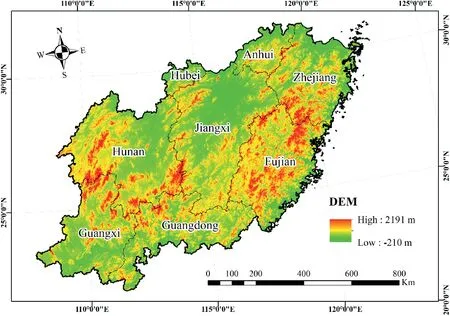
Fig.1.The hilly red soil region(HRSR)of southern China.
The InVEST(Integrated Valuation of Environmental Services and Tradeoffs)model is a suite of integrated models used to map and assign value to ecosystem services,which was jointly developed by Stanford University,The Nature Conservancy,and the World Wildlife Fund(https://naturalcapitalproject.stanford.edu/software/invest).The InVEST model is modular and open-source software(Delphin et al.,2013).The InVEST Carbon Storage and Sequestration is one of the modules that can comprehensively estimate carbon stored simply and reliably(Leh et al.,2013).In addition,the InVEST model can simulate the impact of LUCC on terrestrial ecosystem carbon storage spatially(Chaplin-Kramer et al.,2015).Carbon storage in the terrestrial ecosystem consists of four carbon pools,which are the aboveground living biomass(Cabove),soil(Csoil),belowground living biomass(Cbelow),and dead organic matter(Cdead).Based on the carbon density method,the InVEST model uses land-use/land-cover maps and the average carbon density of four carbon pools of each land-use/land-cover type to estimates carbon storage.The carbon density values for aboveground living biomass and soil were derived from Liu et al.(2019)(Table 1).The belowground living biomass is calculated based on the ratio of aboveground vegetation to the belowground rhizome,which is 0.2(Mokany et al.,2006);the aboveground living biomass is approximately 10 times that of dead organic matter(Delaney et al.,1998b).In addition,the carbon densities of different Land-use types were regarded as fixed values,ignoring their time variations.
3.Results
3.1.Spatio-temporal pattern of GFGP
From 2000 to 2015,the land-use pattern changed significantly in the HRSR of southern China.Forest land and croplands were always the main land-use type.The overlapped results show that,from 2000 to 2015,the total area of the GFGP was about 2052.61 km2in HRSR.Although the GFGP areas continue to expand,the expansion rates are down to about 53 km2/y from a peak of 232 km2/y(Table 2).Among all LUCC,the area of grasslands being returned to forest lands is the largest,accounting for about 69% of the total area.The area of unused land afforestation and grassplanting is far smaller than that of others.The GFGP area is mainly distributed in the Zhejiang and Fujian hilly regions and the Hunan regions(Fig.2).In addition,in terms of space,the implementation of the project shows a trend of transition from east to west.

Table 1 Carbon density in different land-use/land-cover types in the InVEST model(unit:10-4 Tg C/km2).

Table 2 The area of each LUCC type in the HRSR from 2000 to 2015(km2).
3.2.Carbon storage in the in HRSR due to GFGP
Carbon sequestration was estimated in the GFGP area for the years 2000,2005,2010,and 2015.The carbon sequestration in the area in which the GFGP was implemented in the HRSR changed significantly during the period of 2000-2015.Before the GFGP(that is the year 2000),the total carbon sequestration was 19.69 Tg C,with about three-quarters(14.76 Tg C,74.96%)of this being provided by grassland ecosystems.By the end of the first round of the GFGP(that is the year 2015),the total carbon sequestration in the actual occurrence area of GFGP was 22.73 Tg C,an increase of 3.04 Tg C.The change of carbon sequestration per unit area is about 0.0015 Tg C/km2.The area of high carbon sequestration(>0.01 Tg C/km2)is constantly expanding(Fig.3).High carbon sequestration areas were mainly located in the Zhejiang and Fujian regions in 2000,and these areas covered nearly the entire GFGP area by 2015.Carbon sequestration changes were most significant in central Hunan,where the carbon sequestration change was 0.003-0.005 Tg C/km2(Fig.4).Carbon sequestration in Zhejiang and Fujian,where the project has been implemented the longest,had the least significant increase(<0.001 Tg C/km2).This phenomenon is likely related to vegetation management,climate,and other similar factors.
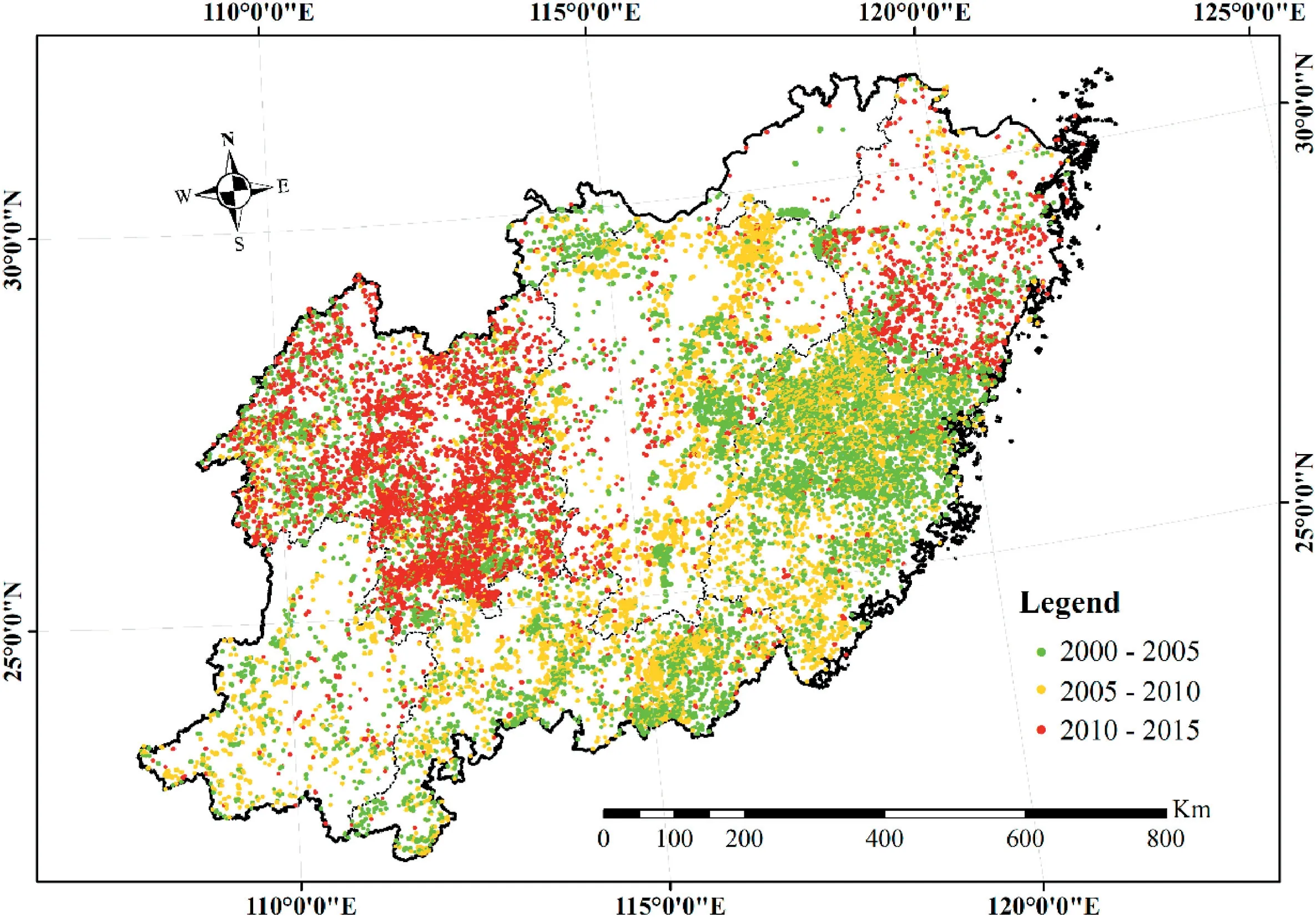
Fig.2.Spatiotemporal distribution map of the Grain for Green Program(GFGP).
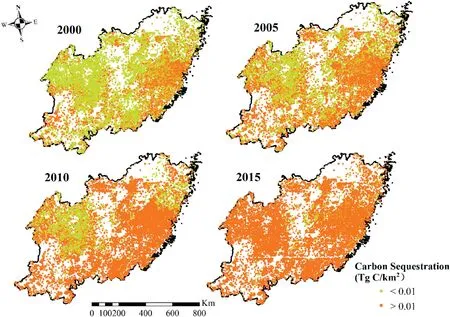
Fig.3.Spatial distribution of carbon sequestration in the GFGP area from 2000 to 2015.
The carbon sequestration of the evaluated carbon pools also increased slightly during the period of 2000-2015(Table 3.).The order of carbon sequestration of the four major carbon pools of the terrestrial ecosystem was Csoil(10.41 Tg C)>Cabove(7.14 Tg C)>Cbelow(1.43 Tg C)>Cdead(0.71 Tg C)in 2000.The carbon storage of the aboveground biomass increased by 2.02 Tg C,which changed from 7.14 Tg C in 2000 to 9.16 Tg C in 2015,thereby having the largest change.The least amount of change(0.21 Tg C)in carbon sequestration was in dead organic matter,which increased from 0.71 Tg C in 2000 to 0.92 Tg C in 2015.The carbon sequestration of the belowground biomass and soil organic matter increased 0.40 Tg C and 0.41 Tg C,respectively,during the period of 2000-2015.

Table 3 Carbon sequestration of different carbon pools in the GFGP area during the period of 2000-2015(unit:Tg C).
3.3.Carbon sequestration among different LUCC types
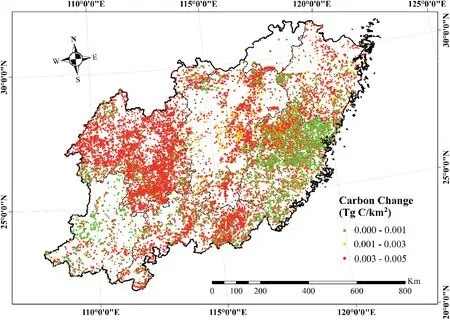
Fig.4.Spatial distribution of the carbon sequestration changes in the GFGP area from 2000 to 2015.
The total change in carbon sequestration is distinctly different among different LUCC types caused by the GFGP(Table 4).Among the LUCC types,the forest land converted from croplands contributes the most to the change in carbon storage in the GFGP area,contributing 1.91 Tg C(62.83%).The amounts from returning grassland to forest land,cropland to grasslands,unused land to forest land,and unused land to grasslands are approximately 0.98 Tg C(32.24%),0.09 Tg C(2.96%),0.03 Tg C(0.99%),and 0.03 Tg C(0.99%),respectively.This phenomenon may be related to the area of each LUCC type in the GFGP region;however,the results of carbon storage per unit area show that the order of the change in carbon storage per unit area was:returning unused land to forest land(0.0048 Tg C/km2)>returning unused land to grasslands(0.0041 Tg C/km2)>returning cropland to forest land(0.0033 Tg C/km2)>returning cropland to grasslands(0.0026 Tg C/km2)>returning grasslands to forest land(0.0007 Tg C/km2).According to the above analysis,for carbon sequestration ecosystem services,unused land afforestation and planting grass is the most effective LUCC type caused by GFGP in the HRSR of southern China.

Table 4 Total carbon sequestration calculated for each LUCC type during the period of 2000-2015.
4.Discussions
4.1.Carbon sink contribution of GFGP
China’s GFGP has played an important role in improving the ecological environment and increasing the carbon storage of terrestrial ecosystems.Feng et al.(2020)suggested that the carbon stocks in some regions are increasing,and this may be related to environmental policies such as returning farmland to forest.It is estimated that policies such as GFGP and straw return programs can offset 3-5% of China’s total emissions each year(Deng et al.,2017;Zhao et al.,2018).In our study,the total carbon sequestration in the GFGP region had a slowly increasing trend,with a growth rate of 15.43% from 2000 to 2015.The total carbon sequestration of the GFGP area in the HRSR of southern China was 22.73 Tg C in 2015,which was equivalent to 1.03% of China’s total carbon emissions(calculated as 2200 Tg in the Durban Conference)in 2010.Carbon sequestration services have been enhanced after the GFGP,which is consistent with previous research(Shi & Han,2014;Wang et al.,2017).
GFGP increased carbon efficiency in terms of both new afforestation and soil conservation(Song et al.,2014).Vegetation sequesters carbon through photosynthesis to reduce atmospheric carbon dioxide.Deng et al.(2017)estimated that the amount of carbon sequestered in China’s forest will be approximately equal to the total estimated carbon emissions(2380-3300 Tg).Soil is the largest terrestrial carbon(C)pool in the world.Every small change in soil carbon has a profound influence on the soil-atmospheric carbon cycle(Shi et al.,2020).In China,the average cumulative rate of soil carbon was estimated to be 0.37 Mg ha-1·a-1after farmland was converted to perennial vegetation(Zhang et al.,2010).Although this region has the largest annual rainfall erodibility in China,its vegetation growth is better.Vegetation has an obvious effect on soil protection and controls soil erosion(Chen et al.,2020).Vannoppen et al.(2015)reported that vegetation restoration generally reduces soil erosion by protecting the soil surface from rain or runoff detachment,thereby increasing the soil surface roughness and the soil permeability,and soil mass stability.Before vegetation restoration,the average erosion intensity is 4151 t/(km2·a),then the average erosion intensity decreased to 846 t/(km2·a)(Chen et al.,2019).Vegetation restoration can reduce carbon loss in runoff and sediment by control soil erosion.It is estimated that vegetation restoration could reduce the annual runoff carbon loss of the entire loess plateau by 7300 Mg(Deng et al.,2019).Besides,Tian et al.(2018)found through metaanalysis that after conversion of farmland to forest,the average retention capacity of soil inorganic nitrogen increases 0.43% when soil organic carbon increases 1%.That is,GFGP not only alleviates climate warming but also contributes to alleviating environmental problems(such as eutrophication of water bodies)caused by N leaching.
4.2.Importance of LUCC on carbon storage
Carbon sequestration is an important service function of terrestrial ecosystems.LUCC is an important factor in controlling the terrestrial carbon cycle(Chuai et al.,2015).LUCC can affect the material circulation and capacity flow of the ecosystem by changing the original ecosystem structure,process and function.Since 1850,carbon emissions from LUCC have accounted for one-third of the global greenhouse gas emissions(Arneth et al.,2017).There is a close relationship between carbon emissions and the use of agriculture,forests,and grasslands(Lai et al.,2016).Forest and grasslands have higher carbon storage capacity than other ecosystems(Pagiola,2008).By analyzing the variation of carbon storage per unit area of the five LUCC types caused by the GFGP in the HRSR of southern China,we found that returning unused land to forest land had the greatest carbon sequestration potential and the conversion of grasslands into forest land has little effect on the increase in terrestrial ecosystem carbon storage.The conversion of other landuse/land-cover types into ecological land will promote the accumulation of carbon,which may be related to the higher soil carbon density and vegetation carbon density of forest land(Feng et al.,2020).When land types with lower biomass were transferred to land types with higher biomass,carbon storage will increase.Zhao,Huang,and Ma(2013)analyzed the carbon storage changes of various terrestrial ecosystems in the southeastern United States and found that the carbon sink in this region is mainly the result of the conversion of farmland to forest.Zhu et al.(2019)found the increase in vegetation carbon storage due to forest land expansion from 1990 to 2010 in Zhejiang Province.LUCC affects vegetation carbon storage by affecting net primary productivity(NPP)and the decomposition of underground vegetation.Meanwhile,LUCC affecting soil carbon storage by changing the soil respiration rate that was affected by soil biochemistry and physical processed.Each LUCC type has different effects on carbon storage.The implementation of ecological engineering projects can increase the proportion of land-use/land-cover types with higher carbon storage capacity,thus increasing regional carbon storage(Zhao et al.,2018).In order to maintain carbon storage and reduce carbon emissions,unused land afforestation and grass planting should be given priority when implementing the GFGP in the study region.China’s GFGP is likely a valid and feasible approach to mitigating climate warming.
4.3.Effect of water resources on tree species
The GFGP has significantly changed ecosystem services.Some scholars have shown that GFGP has increased carbon storage,but may cause serious water resources shortage in an arid and semiarid area where water is scarce(Feng et al.,2016;Su &Shangguan,2019).The main source of soil moisture in HRSR is Precipitation.A study of China’s precipitation from 1960 to 2014 shows that under the background of global warming,the total precipitation in the HRSR has not changed significantly,but heavy rain events have increased significantly(Song,2017).Light rain events only affect the change s in surface soil moisture and are easily consumed by evaporation.Heavy rain events can promote the infiltration of water into deep soil,which makes a great contribution to soil water replenishment(Persson et al.,2013).In the HRSR of China,rainfall is abundant,but there is a seasonal drought problem.Forest may absorb deep soil water in the dry season but can be replenished in the rainy season.Besides,the depth of groundwater is 8-10 m in most parts of HRSR,so it is almost impossible for the forest to extract groundwater.For example,Eucalyptus is one of the main plantation types in the HRSR of Southern China,and water consumption is large.But the transpiration rate of Eucalyptus in HRSR was lower than that in other semi-arid regions.The evapotranspiration of Eucalyptus is most likely to be 900-1200 mm(Zhang et al.,2010).The Eucalyptus plantations introduced will not extract groundwater in most areas in HRSR.That is,the impact of afforestation on water resources in the HRSR is limited(Liu et al.,2016).However,there may be a certain impact in areas with rainfall of less than 1200 mm.For GFGP,water balance should be considered in areas where rainfall is less than 1200 mm.
The planting of plantations should follow the basic principles of suitable trees and land.In an area with abundant rainfall,more consideration should be given to the ecological benefits of vegetation when selecting tree species,while water consumption and drought tolerance of trees also be considered in abundant rainfall areas.For example,tea plants have strong water storage capacity.Mytilaria laosensis tend to form a thicker litter layer and have better soil and water storage capacity.Ormosia Yunnan Eusis and Michelia macclurei had strong tolerance to poor soil and drought.These tree species can be selected for GFGP in the HRSR of southern China(Fang,2002;Satyanaga et al.,2013).In addition,when implementing GFGP,mixed coniferous and broad-leaved forests should be built as far as possible to increase the complexity of vegetation hierarchy and give full play to the role of vegetation in interception and absorption of rainfall.
4.4.Limitation and suggestions for further studies
The GFGP is a typical LUCC process(Deng,Liu,& Shangguan,2014).Many scholars have studied the LUCC brought by GFGP.The series of Landsat images have been widely used in monitoring the LUCC caused by GFGP.For example,You et al.(2020)obtained 100 m resolution land use data based on Landsat images and identified the spatial scope of GFGP on the Loess Plateau based on this data.The method of extracting the GFGP range by the superposition of multi-period land-use/land-cover data has high credibility.In this paper,through the interpretation of multi-temporal Landsat TM images,we obtained the land-use/land-cover dataset in the HRSR of southern China.The identification accuracy of the area in which the GFGP was implemented is influenced by the accuracy of land-use data,the classification of land-use/land-cover types,and the superposition method.In this paper,a grass map of 1:100 million,a vegetation map of 1:100,and a terrain map of 1:100,000 were referenced for remote sensing interpretation.The overall interpretation accuracy is greater than 85%,which has high reliability.However,this paper only interprets the land-use/land-cover types into six,which has a certain impact on the accuracy of the identification results of the GFGP area.The acquisition of more detailed land-use/land-cover data,such as data based on vegetation types,can improve the accuracy of the results.Simultaneously,a static superposition method was adopted to identify the GFGP area.More effective methods,such as using multi-source data and advanced algorithms(such as phenology-based algorithms)to continuously monitor dynamic changes of land-use/land-cover year by year,can effectively improve the accuracy(Dong et al.,2017).On the other hand,more detailed LUCC data need to be obtained,such as land-use data based on vegetation types.The modeling approaches estimate carbon sequestration from GFGP by estimating the precise locations where land conversion occurred.This method is based on the overlap of multiple spatial datasets.Each dataset has its own random errors,which will affect the results.The uncertainty analysis of results and the improvement of the simulation accuracy of the model are the focus of our next research.
This study offers a carbon sequestration analysis framework.We analyze GDGP carbon sequestration from the LUCC perspective.However,there are several limitations from the fact that the carbon density values of different land-use/land-cover types obtained from the literature review used in this paper were fixed values,ignoring their spatial and temporal variations.The carbon density values will change over time due to climate change,human activities,etc.Moreover,the values vary spatially because of geographical and climatic conditions.Therefore,the accuracy of the results can be improved in the future by obtaining the carbon density values of detailed land-use/land cover types and vary over time and space.At this time,a lot of field investigation is particularly important.
5.Conclusions
Large-scale ecological restoration programs such as the GFGP are presumed to be an effective approach to mitigating climate change;however,few studies up to this point have assessed the carbon sequestration benefits of the GFGP in the HRSR.Our results show that the growth rate of total carbon sequestration is 15.43%in the GFGP region from 2000 to 2015,which was able to offset about 1% of China’s annual carbon emissions in 2010.The carbon sequestration per unit area increased about 0.0015 Tg C/km2.There are five LUCC types that resulted from the implementation of the GFGP.Among them,unused land afforestation and grass planting are the most beneficial ways to increase the benefits of carbon sequestration.In conclusion,the implementation of the GFGP in the HRSR of southern China has been conducive to improving regional climate results.Unused land afforestation and grass planting should be the areas of focus when implementing ecological restoration programs such as the GFGP.
Declaration of competing interest
The authors declare that they have no known competing financial interests or personal relationships that could have appeared to influence the work reported in this paper.
Acknowledgements
This research was funded by the National Key Research and Development Program of China(2017YFC0505401).
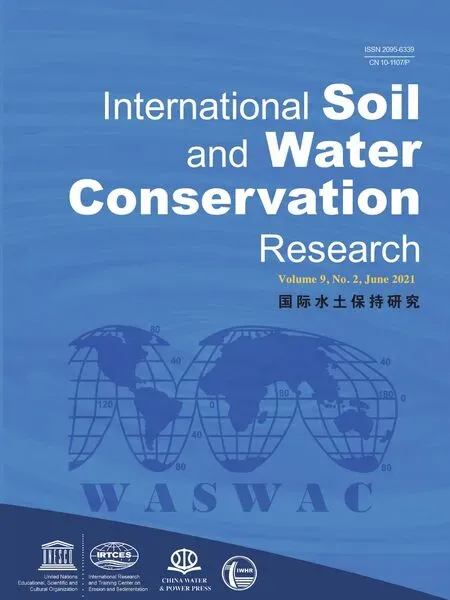 International Soil and Water Conservation Research2021年2期
International Soil and Water Conservation Research2021年2期
- International Soil and Water Conservation Research的其它文章
- Predictions of soil and nutrient losses using a modified SWAT model in a large hilly-gully watershed of the Chinese Loess Plateau
- Potential of conservation tillage and altered land configuration to improve soil properties,carbon sequestration and productivity of maize based cropping system in eastern Himalayas,India
- Crop productivity,soil health,and energy dynamics of Indian Himalayan intensified organic maize-based systems
- Near-saturated soil hydraulic conductivity and pore characteristics as influenced by conventional and conservation tillage practices in North-West Himalayan region,India
- Determinants of adoption of multiple sustainable agricultural practices among smallholder farmers in Nigeria
- Wear of the working parts of agricultural tools in the context of the mass of chemical elements introduced into soil during its cultivation
